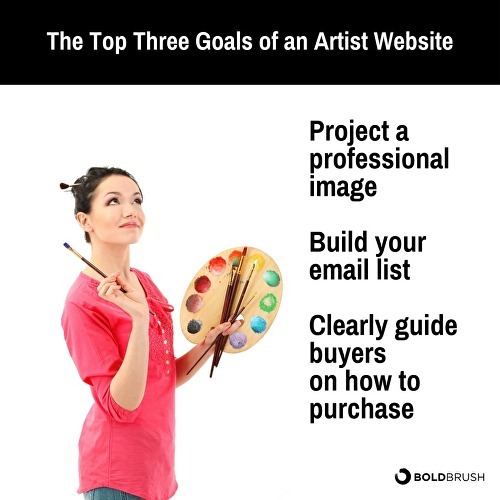Want an art website that really works for you? Bold Brush founder Clint Watson shares important information that every artist needs to know.

AS: What are the top three goals of an artist website?
CW: The first goal of an artist website is to project a professional image of you and your art. To achieve this, you must think about things like your site design, the quality of your images, the loading speed of your site, the color scheme, and if your site looks professional on mobile devices.
The second goal of an artist website is to encourage people to sign up for your email list. This is so important and yet many artists punt on this. Building your own mailing list and direct relationship with your customers is so important that I’m tempted to say it’s almost everything in your marketing. In fact at FASO, we believe that email marketing is so crucial that we design each website to have a newsletter signup box and artist contact information on every single page.
The third goal of an artist website is to clearly direct purchasers on how to purchase your artwork. To achieve this, you must ensure that your art works are priced, that purchasing is easy, and that your e-commerce functionality works properly and simply.
Alternatively, if you sell through art galleries, and not directly from your website, then you can ditch the purchase function and include a link under each art work that sends the purchaser directly to the gallery that carries that piece, since working with the gallery now becomes the next step in your funnel.
Either way, the goal for each art work is to clearly direct buyers into the next step in your sales funnel. As an aside, you should also include an “inquire” button next to each art work as an alternative “next step”, so that the buyer can contact you with any hesitations or concerns. That way, you can solve that concern, and then guide them back into the purchase flow, or, at least garner another prospect for your email list.
While these are the three big goals for an artist website for most artists, I’m purposely ignoring many other use cases such as artists who focus on teaching workshops, or artists who offer digital learning resources for sale. Those artists may have slightly different goals depending on how they primarily make their income.
AS: What are the most important elements that every artist website must have?
CW: There are many elements that an artist website needs to have and the complete list is too long to reproduce in this article. However, the top ones are as follows:
- a simple way to join the artist’s email list
- a design that allows for easy viewing of high-quality images of your artworks
- clear call to action on what steps to take next if interested in purchasing
- a professional design that works seamlessly on mobile devices
- hosting on your own domain name
- served securely over https
There are several more elements that you should have to achieve your goal of projecting a professional image, but just nailing these six would get you quite far. I’ve written longer articles covering this topic alone. You may read one here.
AS: What are the most common questions you hear from artists who want to start their first website?
CW: Because we most often talk with artists at the point that they’ve already decided they need a website, the most common questions we hear are technical questions such as “How do I register a domain?” or “What resolution images do I need?”
We understand that setting up a new website can be a bit overwhelming, so to address the many technical issues involved with setting up and maintaining a website, we, at FASO Artist Websites, offer the industry’s best customer support. We encourage you to talk to us directly via our in-app chat or on by calling us over the phone, and we will guide you through all the technical issues. Additionally, we offer artists the option to have us to simply build your site for you and then let you take over once it’s up and running. Our philosophy has always been to abstract away all these technical issues, so artists simply don’t have to worry about them.
Other than technical questions, the other two common questions are “Why do I need a website at all?” and “How do I get traffic to my website?”
Let’s tackle those one at a time:
AS: Why do artists need a website?
CW: As I mentioned above, there are three main reasons that artists need their own artist websites. But they are worth repeating:
- to ensure that their art is taken seriously
- to project a professional image
- to control their own marketing assets
AS: How do artists get traffic to their websites?
This is a very common question and there are a lot of ways to answer it. There are many marketing channels, strategies and tactics and this is a topic worth an entire article. In fact, that’s the topic of my next article, so stay tuned! But if you can’t wait, teaching artists to turbocharge their art marketing and exploring strategies that help you sell art are what we focus on in our free daily newsletter, FineArtViews: Click here to sign up.
 Clint Watson is a former art gallery owner and founder of BoldBrush, known for FASO Artist Websites, the leading provider of professional artist websites, the $25,000+ BoldBrush Painting Competition and the free daily art marketing newsletter, FineArtViews. As a self-proclaimed “art fanatic”, Clint delights that BoldBrush’s downtown San Antonio, Texas office is full of original art, as is his home office which he shares with his two feline assistants Kiara and Lilly. You can connect with Clint on Twitter, Facebook or his personal blog at clintavo.com.
Clint Watson is a former art gallery owner and founder of BoldBrush, known for FASO Artist Websites, the leading provider of professional artist websites, the $25,000+ BoldBrush Painting Competition and the free daily art marketing newsletter, FineArtViews. As a self-proclaimed “art fanatic”, Clint delights that BoldBrush’s downtown San Antonio, Texas office is full of original art, as is his home office which he shares with his two feline assistants Kiara and Lilly. You can connect with Clint on Twitter, Facebook or his personal blog at clintavo.com.


I would love more info on help w my website! Who do i need to contact?
I have a couple questions. If I put very high quality images of my art work on my site how do I prevent image theft? I noticed you didn’t say anything about adding watermarks to the images that artist posts. Should they be added or would they be considered as distracting from the artwork?
The reason I’ve raised this this is because I have experienced theft of my intellectual property online.. I also have an ebook publishing company, and only just recently found…yet…again books from my site being sold at a distributor I never signed with..and what’s worse, there appears to be no way to trace them. So how do we avoid this happening in the art world?
Piper if you want to have our team assist you with your site, we’d need to move it to FASO, I can offer you an insanely low price on your first year and our team, if you wish, will do all the work to move the content from your old site to your new one. You can direct message us at https://facebook.com/fasosites and just tell them “Clint offered me a deal on ArtsyShark’s blog”
Terrie – that’s a pretty thorny issue. My usual advice usually stems from the fact that if you put it online, you can’t stop people from downloading things. Right click disablers and such are just “security theater” that accomplish nothing really. I would recommend not putting ultra-hi resolution images online. I don’t recommend watermarks personally, they are extremely distracting to legitimate collectors…although our service does provide automatic watermarking should you wish to turn it on. I do recommend having a small attribution overlayed on the image in the lower right or left corner.
Lastly, I would recommend, if this is a concern, registering your copyrights. Many, many artists say this is a big problem and a big concern but don’t actually do the necessary steps to register you copyright. Copyright is subtly different than theft. If I steal your car, then I have it and you don’t. If I re-post your digital image, then we both have it. IN that case, your ability to make money from the image has not been taken away. Thus If someone infringes your copyright there are two things you need to prove: 1. Monetary damages (did the infringer make money from your images somehow? If so – you are entitled to that money) and 2. Did you register the copyright.
Your chances of having a real legal case go up dramatically if the copyright is registered…..BEFORE the infringement happens. If the copyright is not registered, you still have a copyright, but enforcement is dramatically weakened. If you HAVE registered the copyright, you are entitled to the monetary damages AND pretty severe punitive damages.
Lastly, if someone simply has your content and hasn’t really caused you damages, but it upsets you, you can issue a DMCA takedown request against them or the company that hosts them. Example: If your ebook copiers are promoting it through Amazon, you could issue a DMCA takedown request to Amazon to force them to take it down. That often will work, but you’d still need to have to copyright registered if it went any further than that and required legal action.
Lastly, I should point out, I am NOT a lawyer so please don’t take any of this as official legal advice.
I hope that helps!
Hi Clint,
I have been debating changing my site. For several years I have been using art span. I recently began working full time i the studio developing a solid body of work; therefore, I have not been terribly concerned about the viability of my site. I was introduced to FASO when I became a member of OPA.
When I am ready( I would like to have at least 1-15 new works in series available for sale before I change my site. Currently Most of the images are sold.
What is the best course of action: Wait until the end of the summer or change now and build as I paint or wait until I have a a number of paintings available?
I am trying to keep newsletters current and would like to begin a blog.
Thanks
Aleta Gudelski . aletagudelski.com